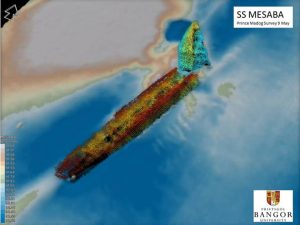
Un grupo de investigadores de la Universidad de Bangor (Gales) encuentran, un siglo más tarde, los restos del barco que trató de salvar al Titanic de chocar contra un iceberg.
La noche del 14 al 15 de abril de 1912, el RMS Titanic se hundía en el Océano Atlántico Norte tras impactar con un témpano de hielo. La colisión provocó la ruptura de varias planchas del casco en estribor bajo la línea de flotación. Dos horas y media después, el barco estaba hundido por completo, habiendo cobrado la vida de 1517 personas. Según el informe del Senado de Estados Unidos, de los 2223 tripulantes, tan solo sobrevivieron 706.
Varios días antes del suceso, el vapor mercante SS Mesaba advirtió al Titanic, a través de un mensaje de radio, la presencia de icebergs a pocas horas de distancia. Sin embargo, este mensaje nunca llegó al puente. Seis años después, durante la I Guerra Mundial, este barco mercante fue torpedado por el submarino alemán U-118 en 1918. Veinte personas perdieron la vida mientras realizaban un viaje de convoy de Liverpool a Filadelfia.
El grupo de investigadores de la Universidad de Bangor ha identificado los restos de este barco en el Mar de Irlanda. Para su hallazgo, han utilizado un sonar multihaz instalado en el buque de investigación Prince Madog.
El Mar de Irlanda está lleno de restos de barcos; se estima que pueden encontrarse alrededor de 273 navíos en el fondo marino. El sonar multihaz permite el mapeo del lecho marino con mucho detalle. Este instrumental, utilizado por los investigadores, permitirá generar más noticias de descubrimientos como este.
__
WRECKAGE OF SHIP THAT TRIED TO SAVE THE TITANIC FOUND
A group of researchers from Bangor University (Wales) find, a century later, the remains of the ship that tried to save the Titanic from hitting an iceberg.
On the night of April 14th-15th, 1912, the RMS Titanic sank in the North Atlantic Ocean after hitting an ice floe. The collision caused several hull plates to break off the starboard hull below the waterline. Two and a half hours later, the ship was completely sunk, having claimed the lives of 1517 people. According to the U.S. Senate report, of the 2223 crew members, only 706 survived.
Several days before the event, the merchant steamer SS Mesaba warned the Titanic, through a radio message, of the presence of icebergs a few hours away. However, this message never reached the bridge. Six years later, during World War I, this merchant ship was torpedoed by the German submarine U-118 in 1918. Twenty people lost their lives while on a convoy voyage from Liverpool to Philadelphia.
Researchers from Bangor University have identified the wreckage of this ship in the Irish Sea. They have used a multibeam sonar installed on the research vessel Prince Madog to find it.
The Irish Sea is full of shipwrecks; it is estimated that about 273 ships can be found on the seabed. Multibeam sonar allows the seabed to be mapped in great detail. This instrumentation, used by the researchers, will enable more news of discoveries like this to be generated.
__

